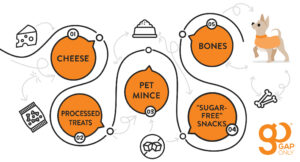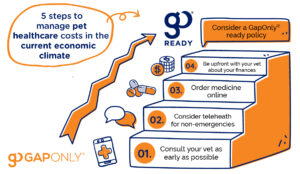According to the American Veterinary Medical Association, one in four dogs will develop cancer during their lifetime#.
So this Pet Cancer Awareness Month, we wanted to provide a guide to educate pet parents about the the breeds that claim more frequently for cancer, some of the signs of cancer, average treatment costs and preventative steps pet parents can take to minimise the risk of cancer in their fur baby.

What are common types of cancer in dogs?
According to 2022 claims data from PetSure* (the power behind GapOnly), the five most common cancer types in dogs were:
- Mast cell tumour
- Lymphoma
- Sarcoma
- Carcinoma
- Osteosarcoma
Which dog and cat breeds are most impacted by cancer?
While any breed of dog or cat is at risk of developing cancer, some breeds are known for having a higher risk than others. In 2022, the breeds that were diagnosed with cancer the most frequently according to PetSure claims data* were:
Dog breeds that claimed most frequently for cancer, 2022
- Bull Mastiff
- Boxer
- Bernese Mountain Dog
- Greyhound
- Bull Terrier
Excluding dog breeds with under 5000 policies
Cat breeds that claimed most frequently for cancer, 2022
- Abyssinian
- Russian Blue
- Siamese
- Tonkinese
- Maine Coon
Excluding cat breeds with under 2000 policies
Signs of cancer in pets
The signs of cancer can vary significantly depending on the body system affected and the advancement of the disease. However, some signs of cancer to be aware of are:
- Skin: lumps, wounds, ulceration, scabs, or swelling that remains or get bigger.
- Gastrointestinal signs: vomiting, diarrhoea, blood in stool or vomit, constipation.
- Systemic changes: lethargy, weight loss, changes in appetite, persistent bleeding, breathing changes or difficulties, a sudden collapse, persistent bleeding or swollen lymph nodes (lymphadenopathy).
- Neurological/Orthopaedic/Musculoskeletal signs: changes to ambulation, activity, incoordination, lameness, other signs of pain, swelling, vision loss or changes or seizures.
- Reproductive/Urinary: changes in urination frequency or volume, mammary swelling or ulceration, testicular swelling, vaginal/penile discharge.
- Oral signs: Drooling, changes in eating habits, swallowing difficulties, halitosis, losing teeth, masses in the mouth.
If you think your pet is presenting any unusual signs, make sure you seek advice from your vet as soon as possible.
So what are the average treatment costs for cancer?
PetSure claims data for 2022* shows total cancer claims for both dogs and cats in 2022 was around $25.8 million. The cancer type with the most claims for dogs was mast cell tumour, with an average treatment cost of $2,587 while the cancer with the highest claims for cats was Lymphoma with an average treatment cost of around $3,864.
Top 5 cancers in dogs and their costs 2022
| Cancer | Average claim cost | Highest claim cost |
|---|---|---|
| Mast Cell Tumour | $2,587 | $27,304 |
| Lymphoma | $4,725 | $32,925 |
| Sarcoma | $2,979 | $25,480 |
| Carcinoma | $3,908 | $36,980 |
| Osteosarcoma | $4,179 | $25,845 |
Top 5 cancers in cats and their costs 2022
| Cancer | Average claim cost | Highest claim cost |
|---|---|---|
| Lymphoma | $3,864 | $24,171 |
| Mast Cell Tumour | $2,310 | $10,764 |
| Carcinoma | $4,354 | $26,705 |
| Squamous Cell Carcinoma | $1,343 | $4,642 |
| Adenocarcinoma | $2,151 | $10,104 |
So what steps can pet parents take to minimise the risk of cancer in pets?
Lifestyle choices
Feeding your pet a nutritional and balanced diet (and avoiding any high-risk foods) helps maintain a healthy immune system and a healthy weight which can reduce the risk of some cancers. Exercise should be part of your preventative care to help maintain a healthy weight for your four-legged friend.
Avoiding household toxins
Reducing your pet’s exposure to environmental toxins or chemicals, such as pesticides^ and herbicides, household cleaners, some toxic plants, and human medications can also help minimise the risk of your pet developing cancer.
Sun protection
Some pets can develop cancers relating to sun exposure. Squamous Cell Carcinoma (SCC) is a malignant cancer that affects cats and dogs and is understood to be UV induced. Lighter coloured pets are more susceptible to sun damage, so keeping lighter coloured pets indoors or covering them with t-shirts may help prevent sun damage and the risk of certain cancers.
With one in four dogs facing cancer during their lives, it’s important to understand the common signs of cancer and the role of early detection and preventative care in minimising your pet’s risk so they can live a happy and healthy life.
References
#American Veterinary Medical Association – https://www.avma.org/resources/pet-owners/petcare/cancer-pets
*PetSure claims data (2022)
^American College of Veterinary Internal Medicine (2008) – https://onlinelibrary.wiley.com/doi/abs/10.1111/j.1939-1676.2003.tb02424.x
National Library of Medicine (2015) – https://www.ncbi.nlm.nih.gov/pmc/articles/PMC6314649/








